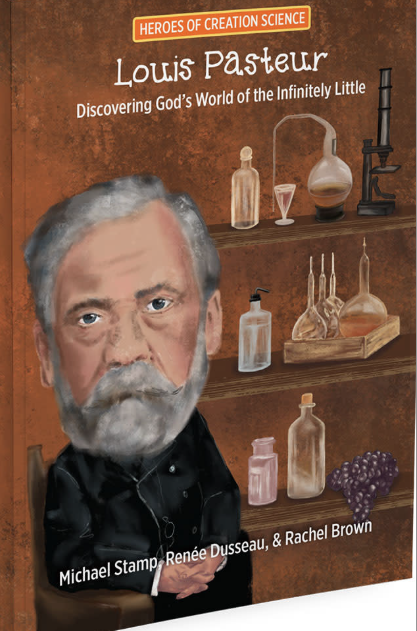Archive
It went on and on. I kept pulling the panels out and there were more. This book is cool because it has real time lines. It goes from the creation in 4004 B.C. to 2001 when the iPod was invented (I’m not talking about the iPod Touch I mean the original iPod)! That is a lot of fast change!
The book tells us about the early people. We follow Bible history, world events, inventions/technology and civilizations/empires. We see what happened all at the same time. Stonehenge in England was built just after the flood. Most history books don’t tell us that. And it is funny to talk about, but sort of cool, that the yoyo was invented in 500 B.C. Read the rest of this entry »
Sometimes it seems as if information is the most important commodity in our technological age. Information, of course, can be put to good or bad uses. We would all agree, no doubt, that computer viruses are a bad use of information. In that situation, a small piece of computer code (information), once it is inside your computer, can take over the whole operating system, with disastrous results for your interests. Of course such problems are nothing new. The term “virus” comes from natural phenomena that do the very same thing to living cells. Invading information occurs to even the smallest cells, bacteria. In fact, some of the bacteria that most threaten our health, are themselves the victims of invasive information from outside unrelated sources. Consider the case of the infamous Escherischia coli 0157:H7, cause of potentially fatal hamburger disease and in some isolated situations, contaminated water. Read the rest of this entry »
Woodpeckers (family Picidae) are found almost everywhere on the continents except extreme polar regions. Most species live in forests or woodland habitats, and many of the about 30 genera and 214 known species are now threatened due to loss of habitat or habitat fragmentation. The smallest woodpecker is the Bar-breasted Piculet (seven grams and eight cm tall) and the largest is the Imperial Woodpecker (average over 600g (1.3 lb) and 58 cm (23 inches) tall. Some species exhibit differences in appearance of the sexes such as body size, weight and bill length. In such cases, the males are larger. Read the rest of this entry »
Eggs are complex structures designed to allow the embryo to develop outside of the mother’s body. An animal egg (Latin, ovum) provides a protective shell in which an embryo can develop. In most birds, reptiles, insects, mollusks, fish, and monotremes (mammals that lay eggs instead of giving birth to live young), the egg contains an ovum or, if fertilized, a zygote. A zygote results from fertilization of an ovum, and develops into an embryo. Read the rest of this entry »
Have you ever wondered how this transformation takes place? The caterpillar makes his cocoon (or chrysalis) and out pops the butterfly – pretty simple, right? Simple – until you realize that nearly every single organ in the caterpillar body is destroyed and then remade into a beautiful butterfly. Eat leaves? Now change your diet to drinking nectar. Those tiny suction-cupped feet? Forget those – now you can fly with wings that make the whole world envious of your beauty. Read the rest of this entry »
If bats were prettier to look at, we might appreciate their amazing talents more. The fact is that bats exhibit some astonishing design features which our engineers and technologists really envy. Traditionally scientists have grouped bats according to their food preferences. There are the fruit bats with good eyesight, the insect consuming, echolocating bats and the vampire or blood consuming bats. Further research has revealed how amazingly these animals are designed for their life styles. Such studies have also revealed that the old fashioned ways of categorizing the creatures according to lifestyle and physical appearance do not really work. This has had some serious implications for ideas concerning whether Darwinian evolution could ever work or not. Read the rest of this entry »
CSAA’s featured speaker for Creation Weekend 2011 was well known creation apologist Dr. Jerry Bergman. Large numbers of people came to hear one or more of his lectures and all declared themselves delighted with his genial, non-confrontational manner and his interesting material. In that Dr. Bergman’s area of expertise is biology, chemistry and medical anatomy, the issues he discussed were quite different from the geological topics which we have considered in recent years. This material demonstrated anew that the issue of creation is broad and encompasses all aspects of nature. Read the rest of this entry »
Diatoms are a major group of plants which float in open water, and they are one of the most successful types of microscopic algae known. The estimated over 100,000 known species are found in the oceans, in freshwater, in soils and even on damp surfaces. Most diatoms are unicellular, although some can form colonies in the shape of long filaments or ribbons. As eukaryotes or cells with a nucleus, they have highly complex cells, comparable to other eukaryotes such as mammals and even humans (Philippe, et al., 1994, Journal of Evolutionary Biology 7: 247). Read the rest of this entry »
Have you ever noticed that everybody seems to place a high value on problem solving? I can well imagine one’s mother saying “This room is way too messy! How are you going to manage your clothes, toys, electronic gadgets (or whatever) so that this does not happen again?” She clearly expects you to come up with a plan and to follow it! Possibly you may come up with some way to organize your treasures in order to keep mum happy. Read the rest of this entry »
Perhaps one of the most famous books in the western world is Darwin’s Origin of Species, published in 1859. Most people with an interest in science, will remember that 2009, the one hundred fiftieth anniversary of the publication of this book, was marked by celebrations which were frequent and fervent. It seems fair to ask therefore precisely why this book merits such attention. Read the rest of this entry »
Dinosaur books are everywhere. There is no doubt about that. And you might well suppose that there is nothing new under the sun when it comes to discussions about dinosaurs. However Albertan Vance Nelson of Creation Truth Ministries has achieved the seemingly impossible. His argument about dinosaurs is new and fascinating. And the book is magnificent with beautiful illustrations from sites around the world. Also there are wonderful dinosaur reconstructions based on the latest scientific information. Read the rest of this entry »
There are a lot of books on Darwin in existence, and these tend to idolize him. This book is quite different. It is undoubtedly a major contribution to the history of science. Even if you already know a lot about Darwin, you will learn something new. Read the rest of this entry »
Few youngsters can resist the excitement of those scary, but mysterious creatures called dinosaurs. Naturally there are lots of books about dinosaurs. Most are written with a young audience in mind. Some, of course, are better than others. While most of the dinosaur books published today feature wonderful illustrations, many of these books unfortunately interpret these creatures in an evolutionary context. Still, there are a number of dinosaur titles which promote a young earth view. Read the rest of this entry »
Imagine a dinosaur being swept far out to sea. It might seem like a crazy idea, but it appears that such an event happened in many places. The story however becomes even more amazing when we learn that these victims were unusually heavy creatures for their size, the kind that would be expected to sink like a stone once they were in water over their heads. To some, the story may not come as a complete surprise however. Way back in the dark ages, for example in the spring of 1995, an item appeared in Dialogue. In part, it ran as follows…… Read the rest of this entry »
Of all the scientific disciplines which resist solution, earthquake prediction certainly ranks close to the top of the list. One need only review the history of recent major events to discover how difficult this issue is. Read the rest of this entry »






